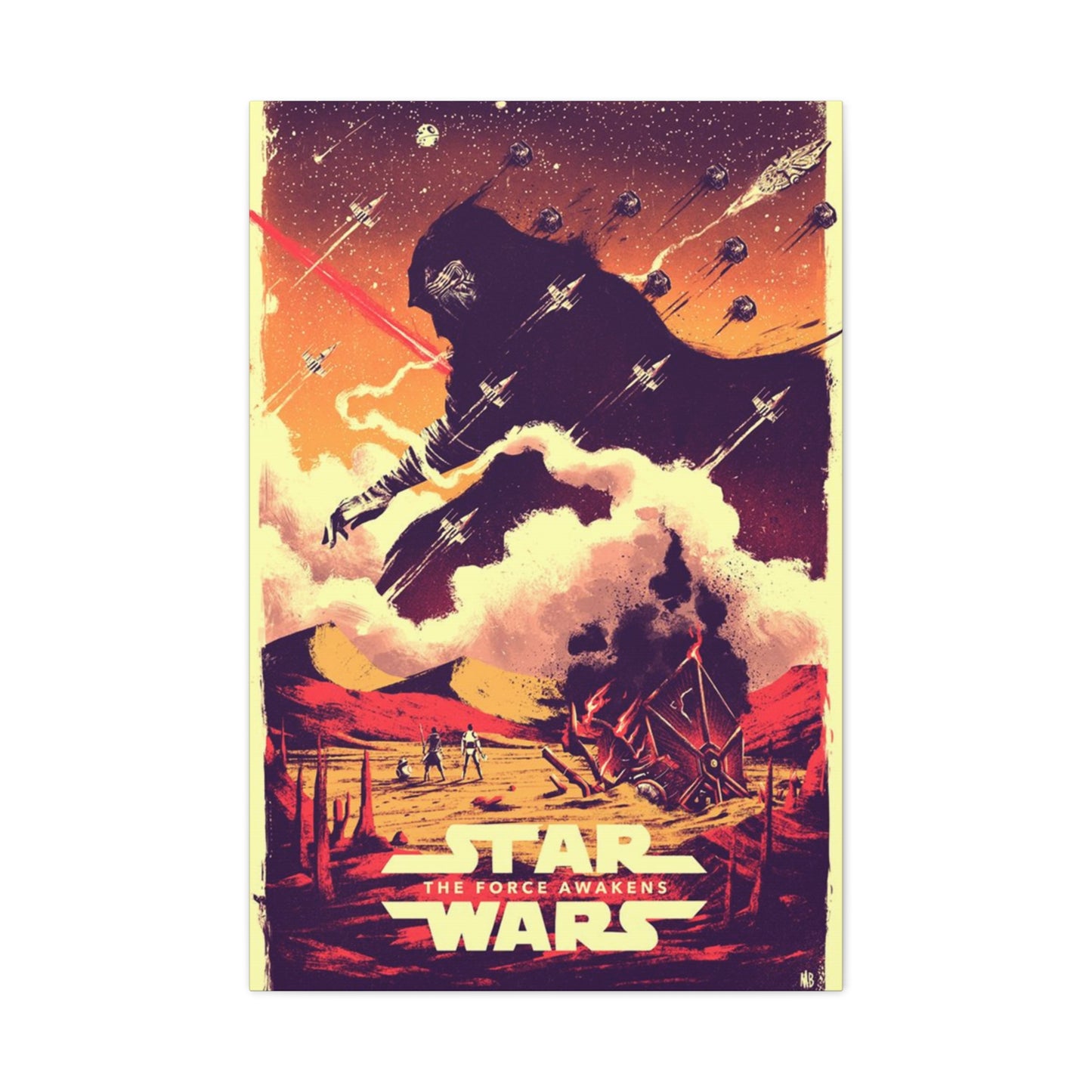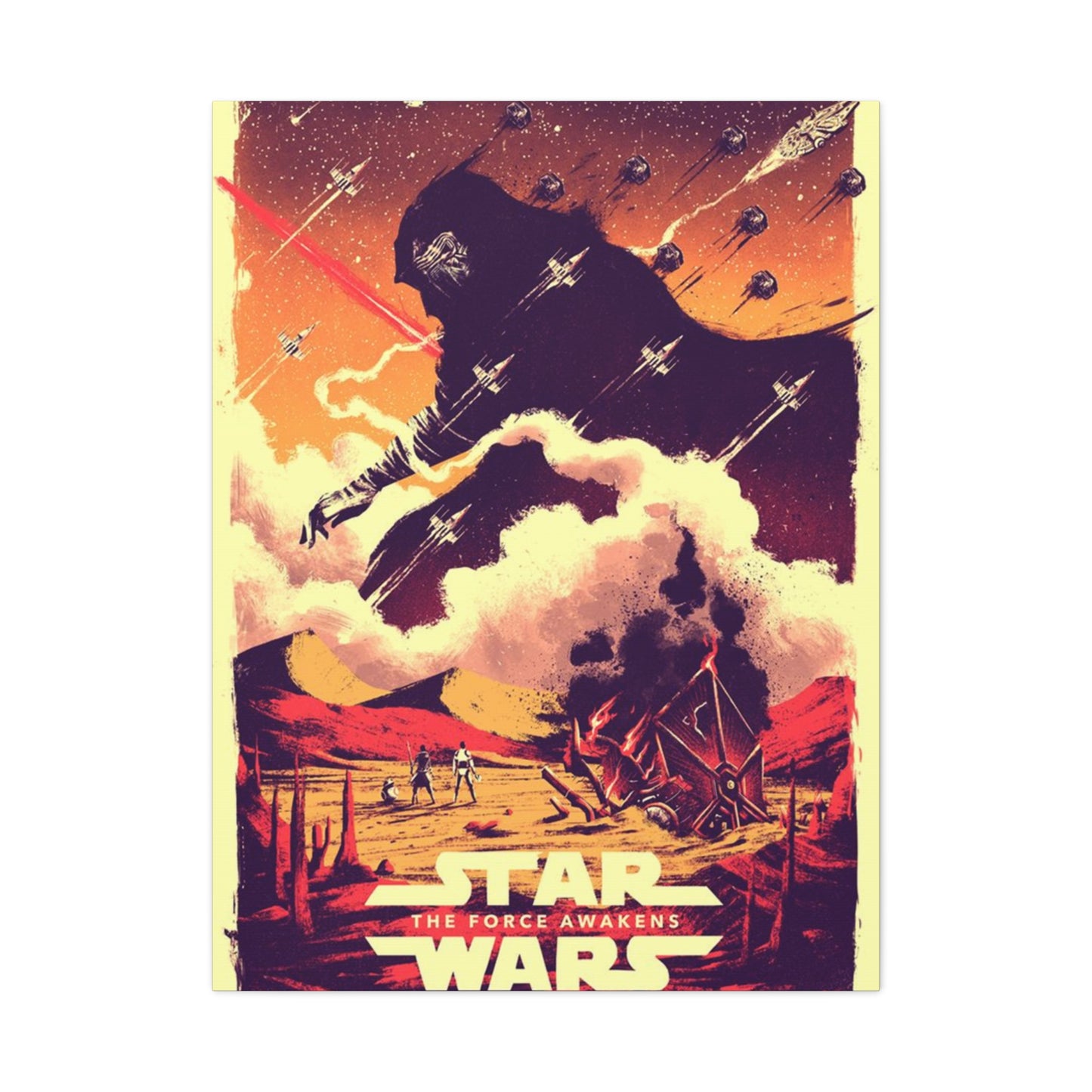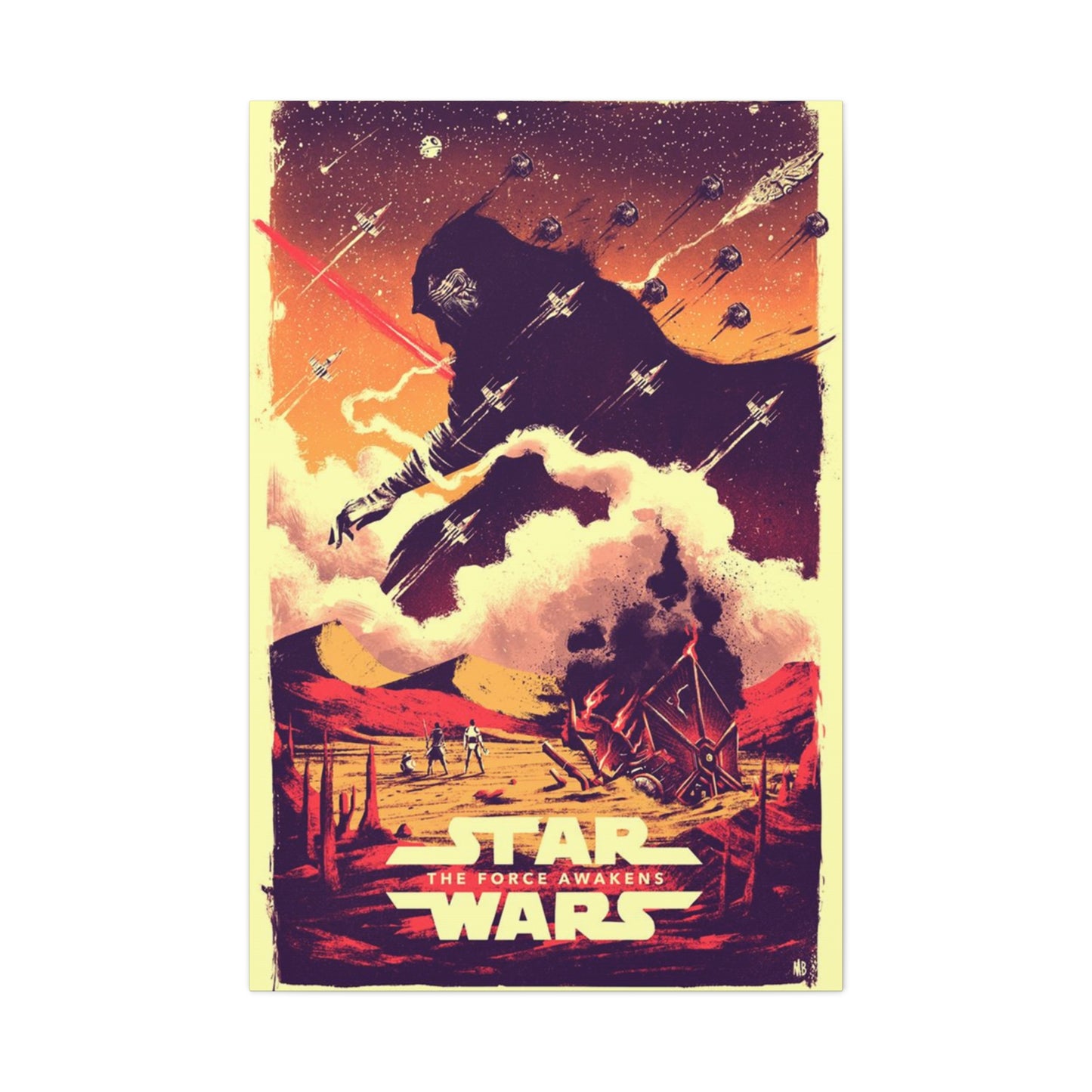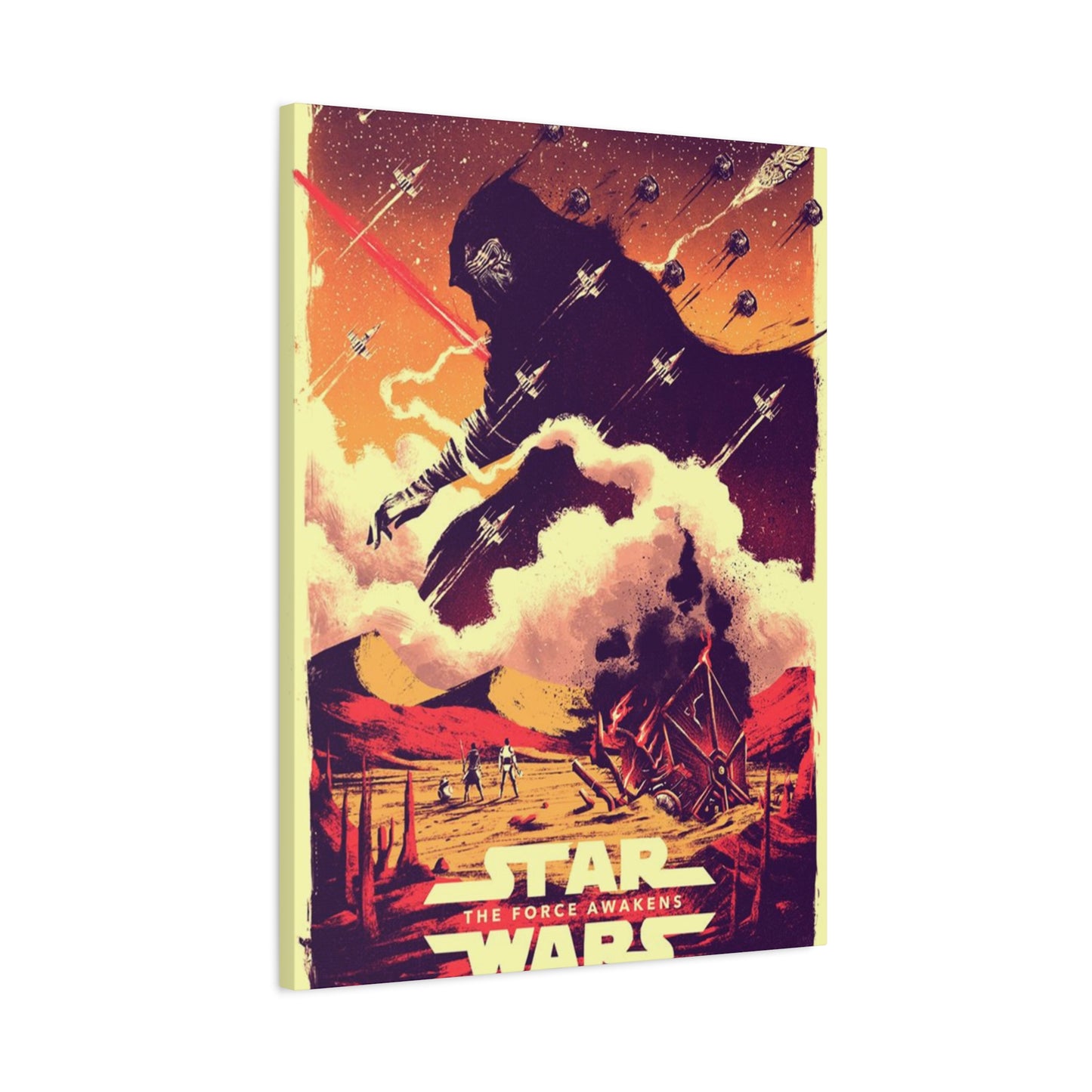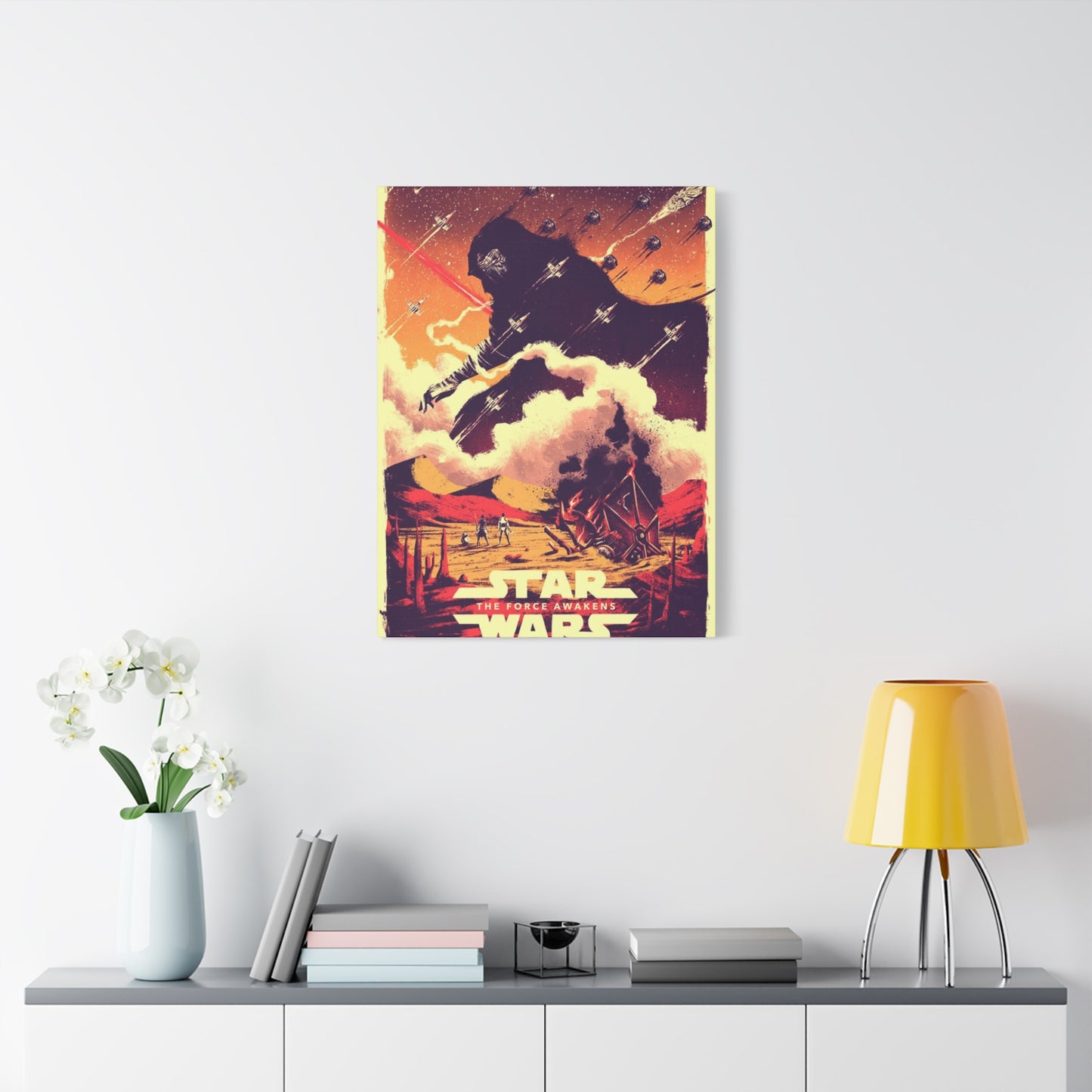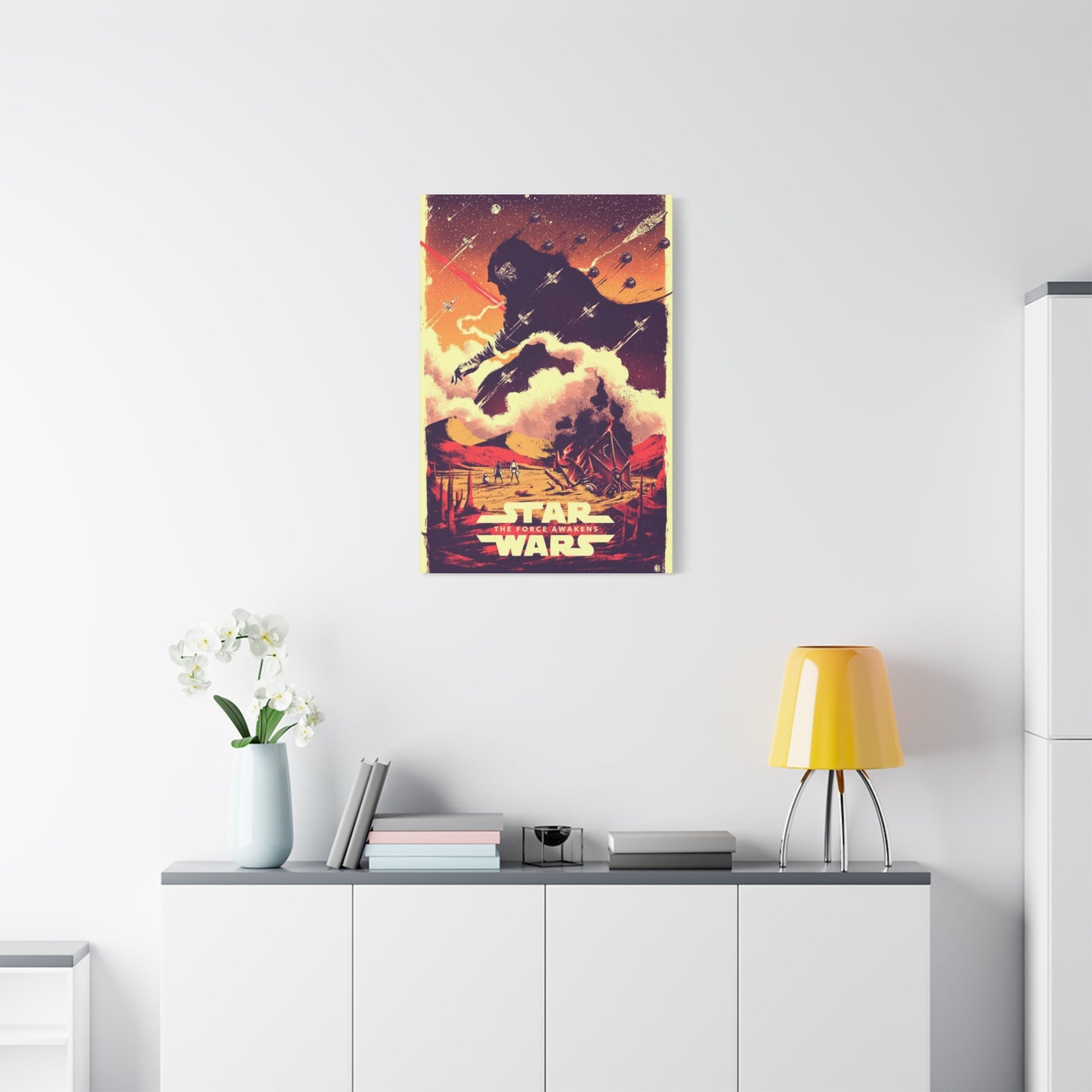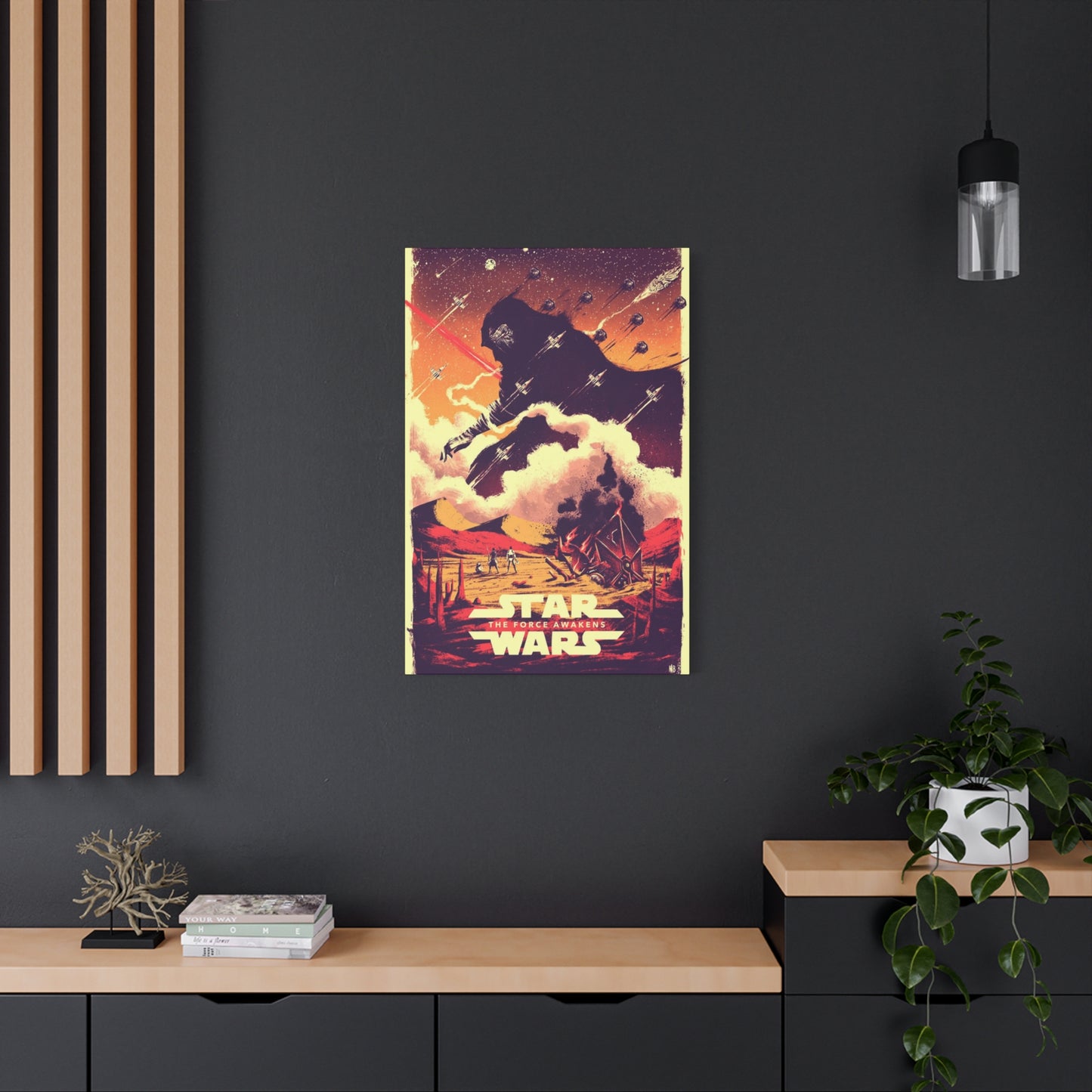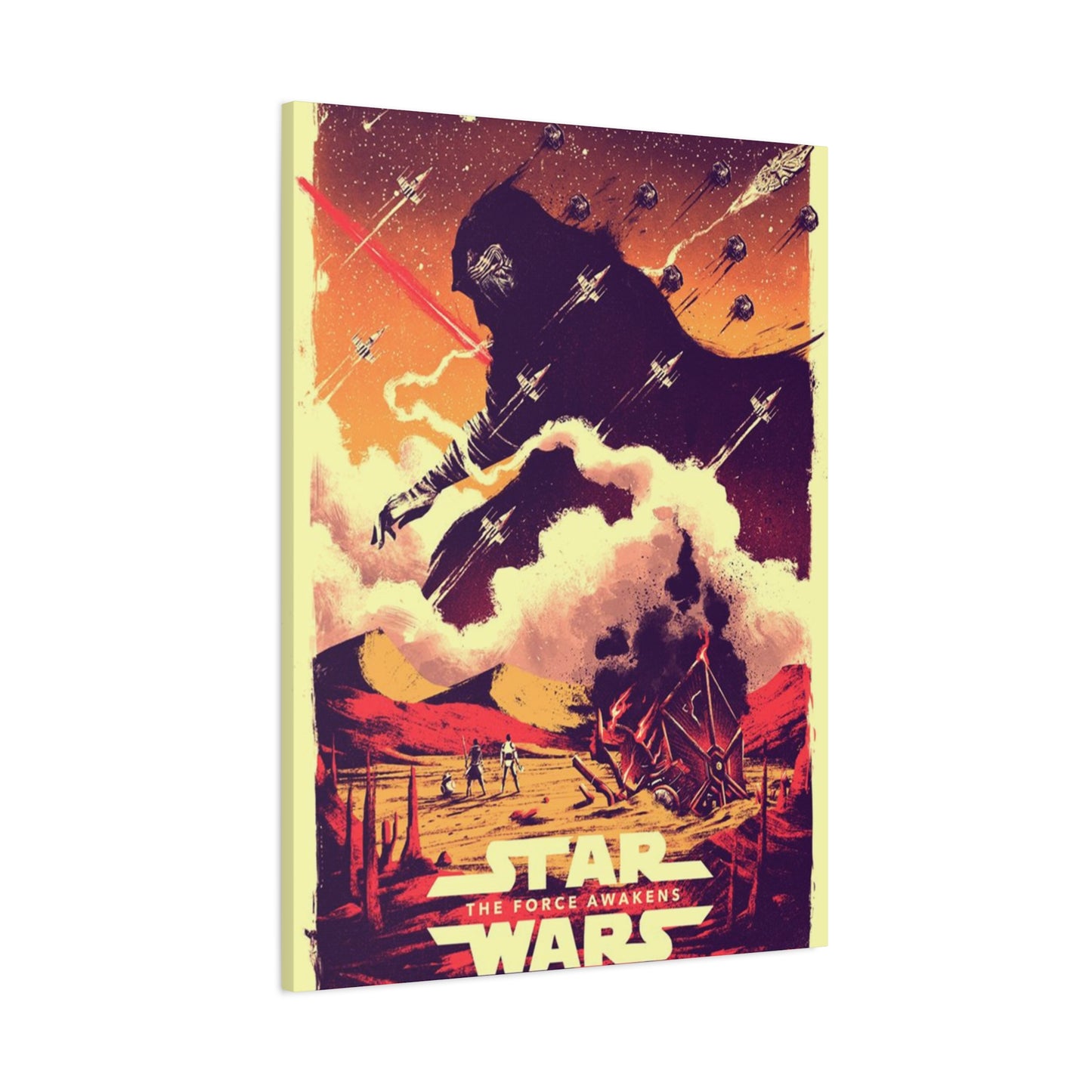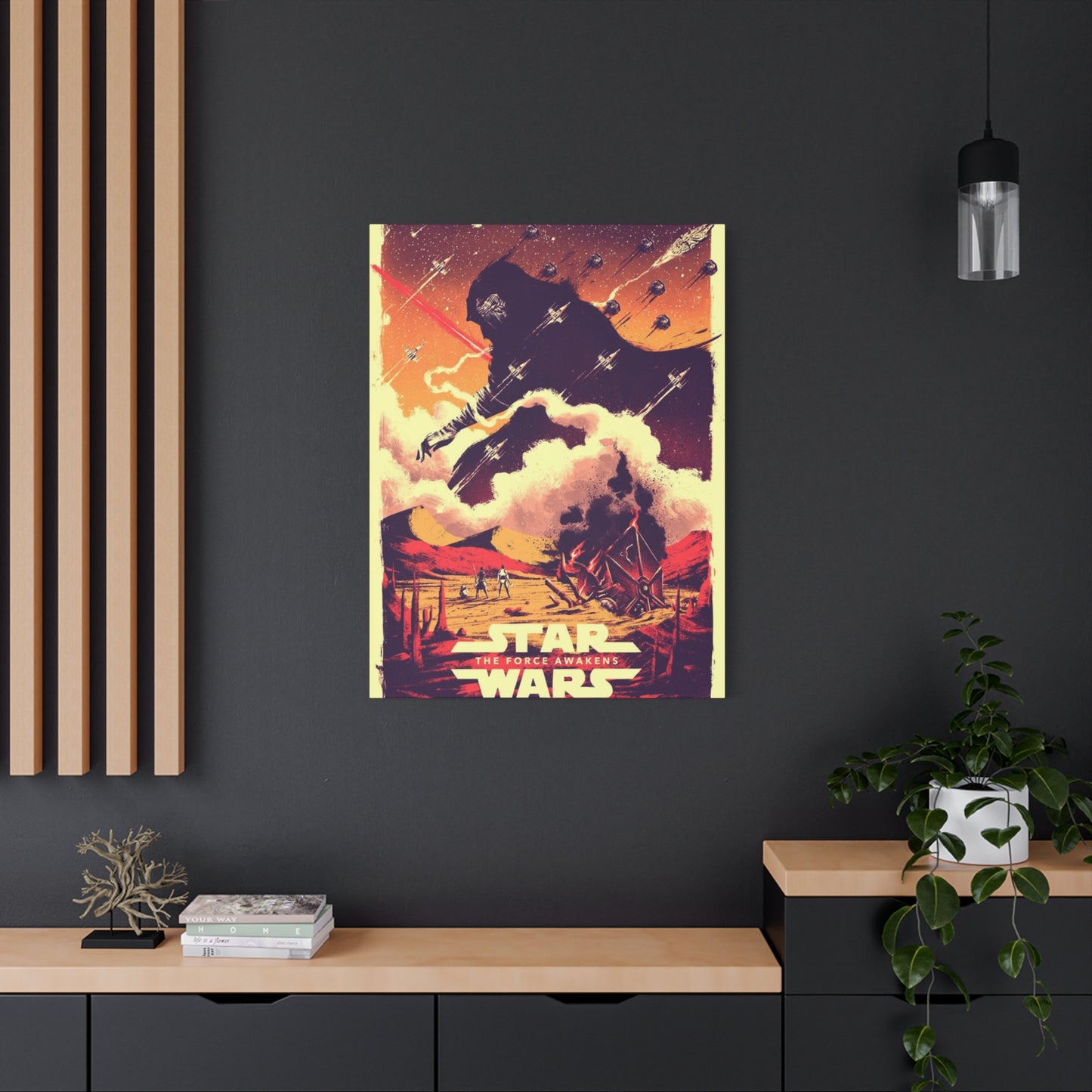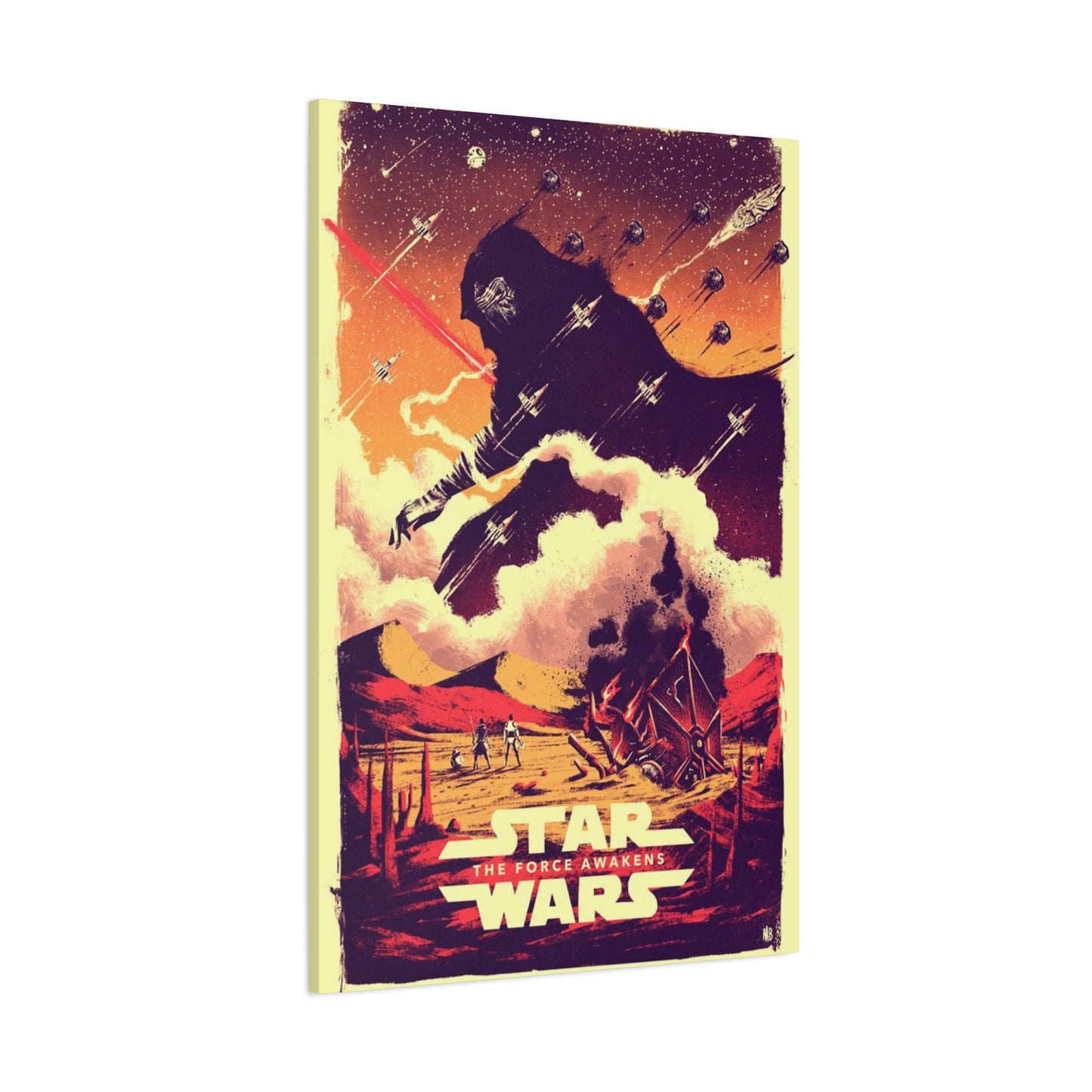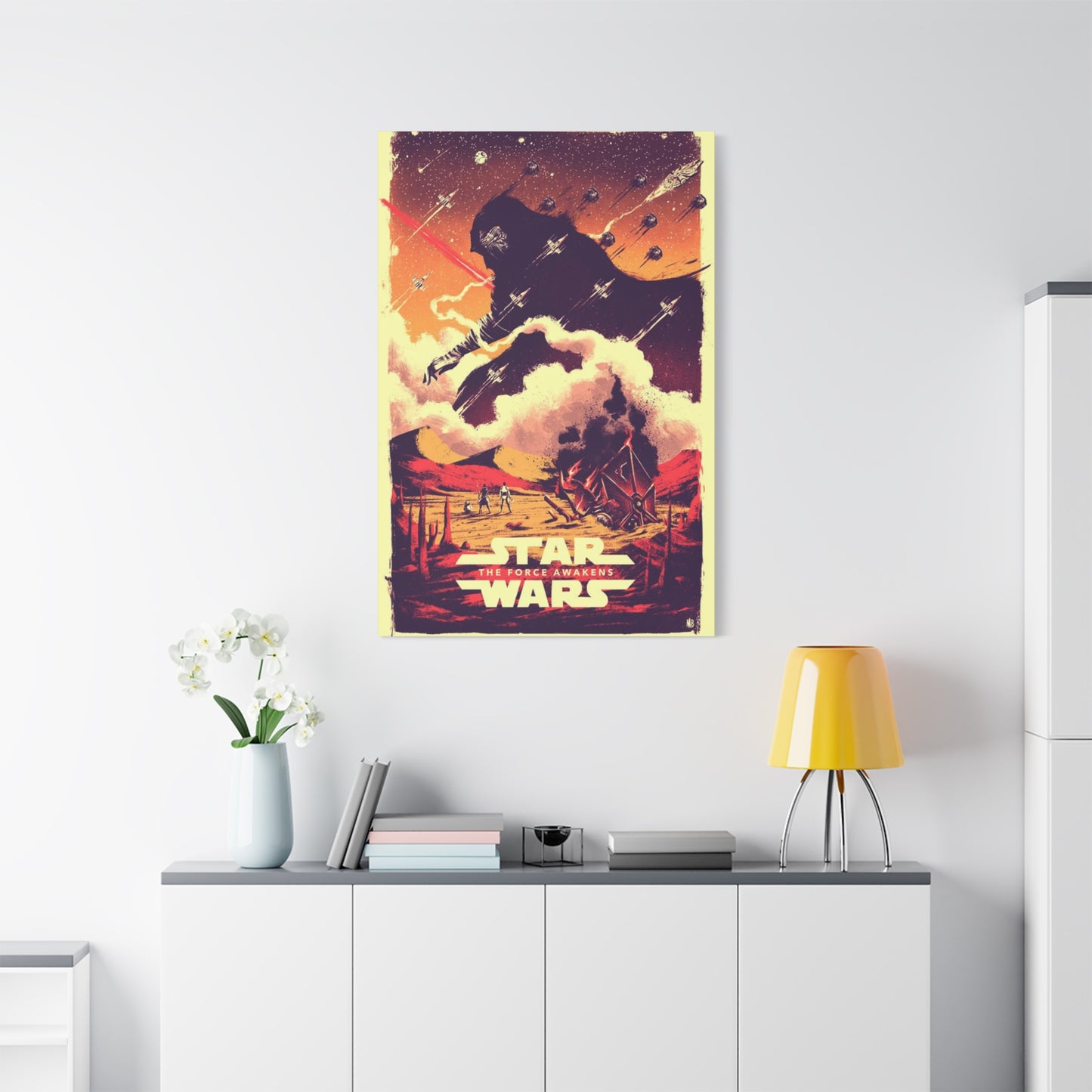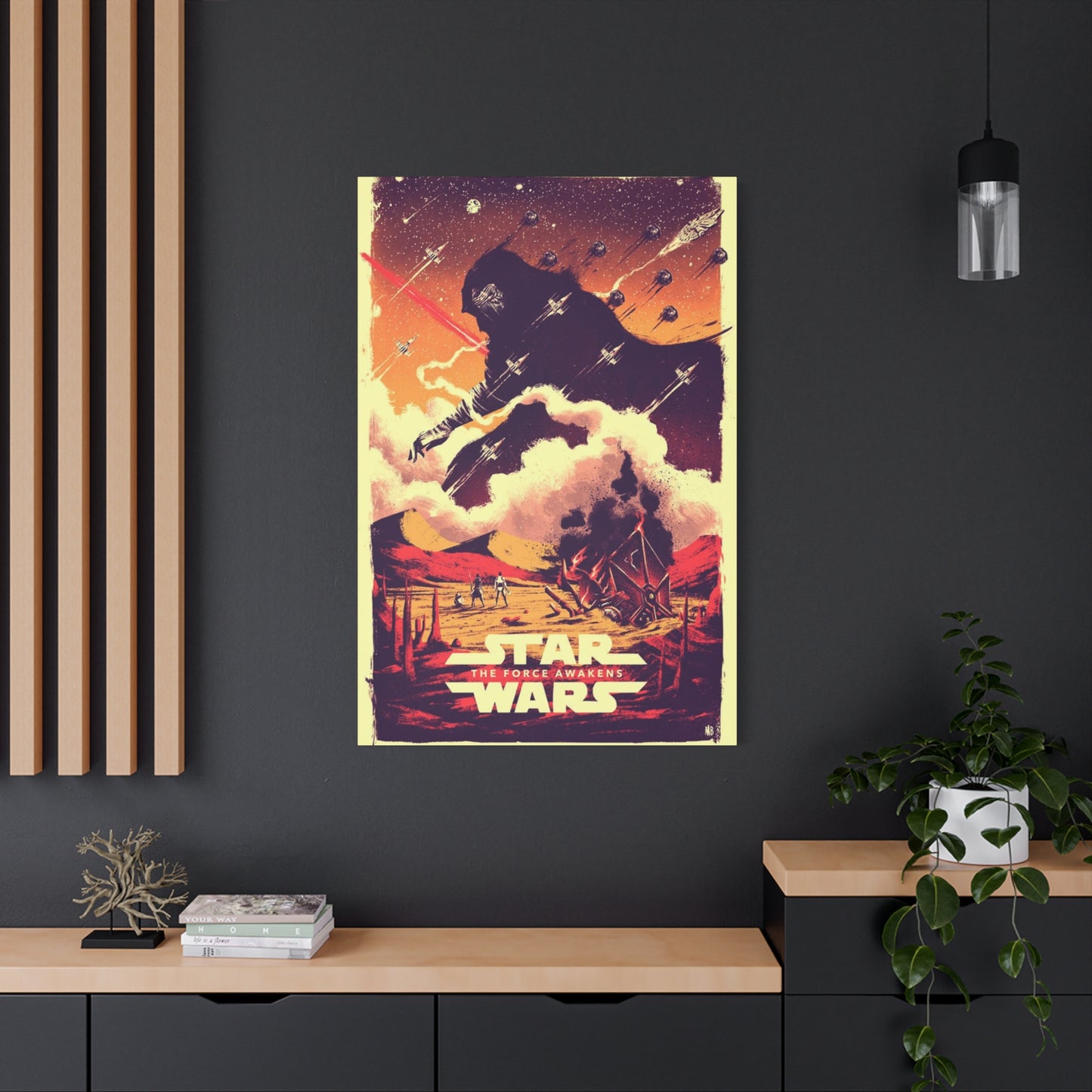The Force Awakens Poster: Elevate Your Space with Iconic Star Wars Wall Art
The world of cinema has given us countless memorable moments, but few franchises have captured imaginations quite like Star Wars. Among the most visually stunning entries in this beloved saga stands Episode VII, which brought fans back to a galaxy far, far away with breathtaking imagery and unforgettable character designs. For enthusiasts looking to bring that cinematic magic into their living spaces, poster wall art and canvas prints offer an exceptional opportunity to showcase their passion while creating striking focal points in any room.
Canvas prints featuring iconic scenes from this landmark film have become increasingly popular among collectors and casual fans alike. These pieces serve multiple purposes beyond simple decoration, functioning as conversation starters, nostalgic reminders, and artistic statements that reflect personal interests and cultural appreciation. The availability of various sizes, styles, and printing techniques means that virtually anyone can find the perfect piece to complement their existing decor while celebrating one of cinema's most significant franchises.
Why Canvas Prints Outperform Traditional Posters
When considering wall art options for displaying beloved film imagery, canvas prints present numerous advantages over conventional paper posters. The material itself provides a gallery-quality appearance that immediately elevates the perceived value of the artwork. Unlike paper that can tear, crease, or become damaged through normal handling, canvas offers remarkable durability that ensures your investment maintains its appearance for years to come.
The texture of canvas adds dimensional depth to printed images that flat paper simply cannot replicate. This textured surface interacts with light in dynamic ways throughout the day, creating subtle variations in how the artwork appears depending on ambient lighting conditions. Morning sunlight might highlight certain color tones, while evening lamp light could emphasize different aspects of the composition, ensuring that your wall art never appears static or boring.
Canvas prints also eliminate the need for glass framing, which can create unwanted glare and reflections that obscure the actual image. Without this barrier between the viewer and the artwork, the visual experience becomes more immediate and immersive. This direct viewing experience allows colors to appear more vibrant and true to their intended appearance, without the dulling effect that glass can sometimes introduce.
The weight and substance of stretched canvas mounted on wooden frames provides a professional, finished appearance straight out of the packaging. Unlike paper posters that require framing to look presentable, canvas prints arrive ready to hang, with the image wrapped around the edges of the frame for a complete, polished look from every angle. This gallery-wrap technique creates a three-dimensional art object rather than a flat image, adding architectural interest to your walls.
Canvas material resists fading better than standard paper when exposed to indirect sunlight, thanks to modern printing technologies and protective coatings. This longevity means your investment continues looking fresh and vibrant long after a paper poster would have begun showing signs of deterioration. The ability to gently clean canvas surfaces with appropriate methods also contributes to their lasting appeal, as accumulated dust and minor marks can be carefully removed without damaging the printed image.
Choosing the Right Size for Your Space
Selecting appropriate dimensions for your wall art significantly impacts how effectively the piece integrates with your existing environment. A canvas that's too small for a large wall appears lost and insignificant, failing to create the visual impact you desire. Conversely, oversized artwork in a small room can overwhelm the space, making it feel cramped and unbalanced. Understanding how to match canvas dimensions to room characteristics ensures successful results.
For living rooms and primary gathering spaces, larger formats typically work best, as these areas benefit from bold statements that anchor the room's aesthetic. A substantial canvas measuring 40 by 60 inches or larger can serve as the focal point above a sofa or entertainment center, immediately drawing the eye and establishing the room's character. These impressive sizes showcase the intricate details and dramatic composition of iconic film imagery, allowing viewers to appreciate artistic elements that might go unnoticed in smaller formats.
Bedrooms often accommodate medium-sized pieces ranging from 24 by 36 inches to 36 by 48 inches, providing visual interest without dominating intimate spaces where relaxation is paramount. These proportions allow the artwork to complement bedroom furniture and personal effects without competing for attention. Positioning at eye level when seated or lying in bed ensures comfortable viewing angles that enhance the overall ambiance.
Home offices and study areas present opportunities for smaller to medium formats that inspire creativity and focus without causing distraction. Pieces measuring 16 by 20 inches to 24 by 36 inches work well in these functional environments, providing enough visual interest to personalize the space while maintaining a professional atmosphere conducive to productivity. Multiple smaller canvases arranged in gallery-style configurations can create dynamic displays that add personality without overwhelming work-oriented spaces.
Hallways and transitional spaces benefit from vertical or square formats that fit naturally within their narrow confines. These often-overlooked areas become more engaging when adorned with appropriately sized artwork that guides movement through the home while showcasing personal interests. Canvas prints in these locations should align with the hallway's proportions, typically favoring taller, narrower dimensions that complement the space's linear nature.
Kitchen and dining areas increasingly incorporate themed artwork that reflects homeowners' interests and personalities. Smaller formats work well in these busy spaces where wall area competes with cabinets, windows, and functional fixtures. Pieces measuring 12 by 16 inches to 20 by 24 inches can add character to these spaces without interfering with the room's primary purposes or creating maintenance challenges in environments where cooking and food preparation occur.
Popular Scenes and Character Designs
The seventh episode of this beloved franchise introduced audiences to new heroes while bringing back familiar faces in unexpected ways. This blend of fresh perspectives and nostalgic callbacks created numerous visually striking moments that translate beautifully to wall art. Understanding which scenes and character compositions resonate most strongly with fans helps in selecting pieces that will provide lasting satisfaction.
Action sequences featuring aerial combat deliver spectacular visuals characterized by dynamic motion and dramatic lighting. These high-energy scenes burst with movement and tension, bringing excitement to any wall they grace. The contrast between dark spacecraft silhouettes and bright weapon fire creates bold graphic compositions that work effectively even when viewed from a distance, making them ideal for larger spaces where visual impact matters most.
Character-focused compositions highlighting individual heroes and villains offer intimate alternatives to sprawling battle scenes. Close-up portraits allow viewers to appreciate costume details, facial expressions, and personality traits that define these beloved characters. These more personal pieces create emotional connections with the artwork, transforming simple decoration into meaningful displays of fandom and appreciation for character development and storytelling.
Group compositions showing the main ensemble cast together celebrate the collaborative nature of heroic storytelling. These pieces capture the camaraderie and determination that define the narrative, presenting characters in unified formations that suggest shared purpose and mutual support. Such imagery reinforces themes of friendship, loyalty, and collective action that resonate beyond simple entertainment value.
Landscape-oriented scenes depicting iconic locations transport viewers to distant worlds and memorable settings. Desert vistas, forest strongholds, and technological installations provide context for the story's events while showcasing the franchise's renowned attention to environmental design and world-building. These panoramic views work particularly well in wider spaces above sofas or beds, where their horizontal orientation naturally complements furniture arrangements.
Minimalist designs featuring simplified graphics and bold color schemes appeal to fans who appreciate modern aesthetic sensibilities. These stylized interpretations distill complex scenes into essential elements, creating clean, contemporary looks that integrate seamlessly with various decor styles. The reduced visual complexity of these designs makes them versatile choices for spaces where subtlety and sophistication take precedence over detailed realism.
Material Quality and Printing Techniques
The longevity and visual appeal of canvas wall art depend heavily on manufacturing quality and printing methodologies. Understanding these technical factors helps consumers make informed purchasing decisions that ensure satisfaction with their acquisitions. Superior materials and advanced printing processes justify higher price points by delivering noticeably better results that stand the test of time.
Cotton canvas represents the premium material choice for art reproduction, offering excellent color absorption and retention properties. The natural fibers create subtle texture variations that add depth and character to printed images, while the material's inherent durability ensures resistance to stretching, warping, and deterioration. High-quality cotton canvas maintains tension on its wooden frame over years of display, preventing the sagging and loosening that plague inferior materials.
Polyester canvas blends provide cost-effective alternatives that still deliver respectable results for budget-conscious consumers. While lacking some of the textural nuance of pure cotton, these synthetic materials offer excellent color vibrancy and maintain their appearance well under normal display conditions. The primary trade-off involves longevity, as polyester may not age as gracefully as cotton over extended periods, though for many applications this difference remains negligible.
Giclée printing represents the gold standard for art reproduction, utilizing specialized inkjet technology to achieve museum-quality results. This process employs archival-grade pigment inks rather than standard dyes, resulting in prints that resist fading and color shifts for decades when properly displayed. The extremely high resolution of giclée printing captures fine details and subtle color gradations that lesser techniques cannot reproduce, creating prints virtually indistinguishable from original artwork at normal viewing distances.
UV-resistant coatings applied to finished canvases provide additional protection against the damaging effects of sunlight exposure. These transparent layers filter harmful ultraviolet radiation while allowing visible light to pass through unimpeded, maintaining color accuracy and vibrancy. The coating also makes surfaces easier to clean and more resistant to moisture and environmental contaminants that might otherwise compromise the print's appearance over time.
Stretcher bar construction significantly impacts how finished canvases appear and how well they maintain their shape. Solid wood frames made from kiln-dried lumber provide superior stability compared to composite materials or green wood that may warp as moisture content changes. Proper corner joinery ensures frames remain square and true, while adequate bar thickness prevents the canvas surface from contacting wall surfaces when hung, which could damage the print through abrasion.
Color Schemes and Interior Design Integration
Successfully incorporating themed wall art into existing decor requires careful consideration of color relationships and stylistic compatibility. The dramatic imagery from this cinematic franchise features distinctive color palettes that can either harmonize with or clash against surrounding elements depending on how thoughtfully selections are made. Understanding basic color theory principles helps ensure that your chosen piece enhances rather than disrupts your space's overall aesthetic.
Warm earth tones dominating desert scenes complement traditional and rustic interior styles beautifully. The golden sands and orange-hued sunsets in these compositions pick up similar tones in wood furniture, leather upholstery, and natural fiber textiles. These warm palettes create cohesive, inviting atmospheres that feel grounded and comfortable, making them excellent choices for family rooms and casual living spaces where relaxation and sociability are priorities.
Cool blue and gray tones prevalent in space-based scenes align naturally with contemporary and minimalist design schemes. These colors suggest sophistication and modernity while maintaining visual calm that prevents spaces from feeling busy or chaotic. The subdued intensity of these cooler palettes makes them appropriate for bedrooms and offices where maintaining focus and tranquility matters more than creating exciting visual stimulation.
High-contrast compositions featuring stark blacks against brilliant whites or vibrant colors create bold statements that work well as focal points in otherwise neutral spaces. These dramatic pieces draw immediate attention and establish clear visual hierarchies within rooms, making them effective choices for modern interiors that embrace strong graphic elements. The key to success with these high-impact pieces involves keeping surrounding decor relatively simple to prevent visual competition and confusion.
Accent color extraction provides a strategy for ensuring artwork coordinates with existing decor elements. By identifying secondary or tertiary colors within the canvas print and echoing those hues in throw pillows, area rugs, or decorative accessories, you create visual connections that tie the room together cohesively. This technique works particularly well when the artwork's dominant colors don't naturally complement your primary color scheme, allowing you to establish harmony through strategic accent coordination.
Monochromatic displays featuring black-and-white or sepia-toned interpretations offer timeless elegance that transcends specific style trends. These classic presentations focus attention on composition, form, and texture rather than color relationships, making them extraordinarily versatile across various design aesthetics. The absence of color also simplifies integration with existing decor, as there are no hues to coordinate or potentially clash with other room elements.
Proper Hanging and Display Considerations
The visual impact of wall art depends not only on the quality of the piece itself but also on how effectively it's displayed within the space. Proper positioning, secure mounting, and thoughtful arrangement significantly enhance the viewing experience while ensuring artwork remains safely in place. Attention to these practical details transforms good artwork into great installations that truly enhance living environments.
Eye-level positioning represents the fundamental principle of artwork placement, ensuring comfortable viewing angles that don't require awkward neck craning or stooping. For most adults, this means centering artwork approximately 57 to 60 inches from the floor to the piece's center point. This standard gallery height creates natural viewing comfort while establishing professional-looking displays that feel intentional rather than arbitrary.
Furniture relationships influence ideal hanging heights in ways that may deviate from standard eye-level rules. When positioning artwork above sofas or beds, maintaining 6 to 12 inches of clearance between furniture top and artwork bottom creates visual connection between elements while preventing the piece from appearing to float disconnectedly. This relationship anchors the artwork to the furniture grouping, creating unified vignettes rather than isolated elements.
Wall space proportions guide decisions about whether artwork should be centered on the wall itself or in relation to furniture below it. For pieces hung on large, uninterrupted walls without furniture beneath them, centering on the wall itself typically produces the most balanced appearance. However, when furniture occupies the lower portion of the wall, centering the artwork above the furniture piece rather than on the total wall span usually creates more harmonious arrangements.
Lighting considerations dramatically affect how artwork appears throughout the day and evening hours. Natural light from windows can illuminate pieces beautifully during daylight hours but may also introduce fading risks if exposure is too direct or prolonged. Strategic positioning that avoids direct sunlight while still benefiting from ambient natural light provides the best compromise between visibility and preservation. For evening viewing, dedicated picture lights or adjustable track lighting can highlight artwork effectively without creating harsh glare or hot spots.
Secure mounting methods prevent accidents and damage while providing peace of mind about valuable displays. For canvas prints weighing under 20 pounds, quality picture hooks rated for appropriate weights typically suffice when anchored into drywall. Heavier pieces benefit from mounting into wall studs using screws or anchors specifically designed for drywall support. Taking time to locate studs with electronic finders or by examining wall construction ensures mounting hardware has solid backing rather than relying solely on drywall strength.
Creating Gallery Wall Arrangements
Multiple canvas prints arranged in thoughtful configurations create dynamic displays with greater visual impact than single pieces alone. Gallery walls allow collectors to showcase various favorite scenes and characters while building layered, personalized installations that tell visual stories. Successfully executing these arrangements requires planning and attention to compositional principles that ensure cohesive rather than chaotic results.
Layout planning before committing to wall placement prevents frustrating trial-and-error adjustments and nail holes. Creating paper templates matching your canvas dimensions and arranging them on the floor allows experimentation with different configurations until finding an arrangement that feels balanced and intentional. This preliminary planning also reveals how much total wall space the arrangement will occupy, helping verify that your vision suits the available area.
Symmetrical arrangements featuring identical or similarly sized pieces create formal, orderly appearances that communicate structure and intentionality. Grid patterns with uniform spacing between elements appear particularly organized and work well in contemporary settings where clean lines and geometric precision align with overall design aesthetics. These balanced layouts suit spaces where visual calm and predictability support the room's purpose, such as offices and formal living areas.
Asymmetrical compositions using varied sizes and irregular spacing produce more dynamic, organic feels that suggest creativity and spontaneity. These arrangements require more careful balancing to ensure visual weight distributes evenly despite irregular placement, but the results can be extraordinarily engaging. The trick involves imagining visual weight rather than physical weight, recognizing that darker pieces or those with busier compositions carry more visual impact than lighter, simpler works regardless of actual size.
Color flow between pieces helps unify gallery arrangements even when displaying diverse content. Positioning pieces so that colors echo between adjacent or nearby canvases creates visual pathways that guide the eye smoothly across the entire arrangement. This color choreography prevents the display from fragmenting into disconnected elements, instead building cohesive installations where individual pieces contribute to a greater whole.
Spacing consistency between elements contributes significantly to professional-looking results. Maintaining uniform gaps of 2 to 4 inches between all pieces creates visual rhythm and prevents arrangements from appearing haphazard or poorly planned. Consistent spacing also simplifies the layout process, as you can focus on overall composition without juggling variable gaps that complicate spatial relationships.
Different Styles and Artistic Interpretations
While photographic reproductions of actual film imagery represent the most common approach to movie-themed canvas art, alternative artistic styles offer fresh perspectives on familiar content. These varied interpretations allow fans to find pieces matching their aesthetic preferences while still celebrating beloved stories and characters. Exploring different artistic approaches reveals surprising diversity within what might seem a narrow niche.
Photorealistic prints directly reproduce actual film frames or promotional materials with maximum fidelity to source material. These pieces appeal to purists who want authentic representations of how characters and scenes appeared on screen. The emphasis on accuracy makes these prints function almost as artifacts from the production itself, preserving exact colors, lighting, and compositions from the original cinematic presentation.
Illustrated interpretations reimagine characters and scenes through artists' unique visual styles. These pieces range from comic-book aesthetics to fine art paintings, each bringing distinctive personality and perspective to familiar subjects. The artistic mediation between source material and final artwork creates new appreciations for characters and stories by highlighting aspects the artists find most significant or compelling.
Minimalist designs distill complex imagery to essential elements using simplified forms and limited color palettes. These modern interpretations appeal to fans who appreciate understated sophistication and contemporary design sensibilities. The reduction of visual complexity makes these pieces versatile across various decor styles while maintaining clear connections to their source material through iconic shapes, symbols, or silhouettes.
Abstract representations use color, form, and composition to evoke emotional responses associated with franchise elements rather than depicting literal scenes. These conceptual pieces challenge viewers to engage more actively with the artwork, finding personal meaning in non-representational visual elements. The interpretive nature of abstract art allows each viewer to bring their own associations and experiences to their understanding of the piece.
Pop art treatments apply bold graphics, bright colors, and graphic design techniques to create energetic, eye-catching displays. This style embraces commercial art aesthetics and mass culture imagery, often incorporating halftone patterns, comic-book coloring, and dynamic compositions. The resulting pieces celebrate popular culture enthusiastically while creating visually striking statements that command attention.
Seasonal and Limited Edition Releases
The canvas print market for popular franchises extends beyond permanent catalog offerings to include special releases tied to specific events, anniversaries, or artistic collaborations. These limited availability pieces create additional collecting dimensions for enthusiasts who value exclusivity and timeliness. Understanding how these special releases work helps collectors make informed decisions about pursuing time-sensitive opportunities.
Anniversary commemorations mark significant milestones in franchise history with specially designed artwork celebrating these occasions. These pieces often feature unique designs created specifically for the anniversary rather than simply reproducing existing imagery. The temporal connection to important dates adds collectible value beyond the artwork's intrinsic aesthetic qualities, making these pieces particularly meaningful for dedicated fans.
Artist collaborations bring fresh perspectives through partnerships between franchises and notable illustrators or designers. These special projects result in original artwork interpreting franchise elements through unique artistic visions, creating pieces unavailable through standard merchandise channels. The combination of popular franchise appeal and respected artistic talent produces highly desirable limited releases that often appreciate in value among collectors.
Seasonal variants offer themed versions of popular images adapted to holidays or seasons. While less common for space-themed franchises than for some other properties, occasional winter or holiday-themed interpretations do appear. These playful seasonal pieces appeal to fans who enjoy celebrating holidays with niche-specific decorations that reflect personal interests.
Convention exclusives debut at fan conventions and similar events, providing special releases available only to attendees or for limited periods surrounding these gatherings. The exclusive nature of these offerings creates scarcity that drives collector interest while rewarding devoted fans who participate actively in community events. Some convention exclusives later receive wider releases, while others remain genuinely limited to original availability.
Production number certifications authenticate limited edition status by documenting each piece's place within the total print run. Numbered editions create verifiable scarcity and collectible value, particularly for early numbers or complete sets. This authentication matters most to serious collectors who view canvas prints as investments rather than simply decorative purchases.
Corporate and Commercial Applications
Beyond residential decoration, themed canvas prints find applications in commercial environments where creating specific atmospheres or communicating brand identities matters. These professional applications demonstrate the versatility of quality wall art while opening market opportunities beyond individual consumer sales. Understanding commercial uses reveals the broader impact and reach of franchise imagery beyond fan collecting.
Entertainment venues including theaters, gaming centers, and entertainment complexes use themed artwork to establish appropriate atmospheres for their businesses. These environments benefit from visually reinforcing the types of experiences they offer, with relevant imagery immediately communicating to customers what kinds of entertainment await. The investment in quality wall art contributes to overall ambiance that influences customer satisfaction and return visits.
Themed restaurants and bars create immersive dining experiences through comprehensive environmental design including appropriate wall art. These establishments understand that customers increasingly seek experiences beyond simple meals, valuing atmosphere and theming as integral parts of their outings. Strategic artwork selection contributes significantly to these experiential environments, helping venues differentiate themselves in competitive markets.
Office spaces occasionally incorporate employee-chosen artwork as part of personalization allowances that improve workplace satisfaction. Forward-thinking companies recognize that sterile, impersonal environments negatively impact morale and productivity, while allowing some personal expression through decoration creates more engaging workplaces. Within reasonable parameters, franchise-themed artwork personalizes cubicles and offices while maintaining professional standards.
Retail environments use thematic displays to create shopping experiences aligned with their merchandise offerings. Stores specializing in collectibles, entertainment merchandise, or niche hobbies benefit from environmental design that immediately communicates their focus to potential customers. Quality wall art serves dual purposes in these settings, both decorating the space and merchandising similar products to interested shoppers.
Educational settings occasionally incorporate popular culture imagery when connecting with students through shared cultural references. Teachers and administrators recognize that sterile classroom environments can hinder engagement, while thoughtfully selected decorations create more welcoming spaces. Franchise artwork with positive themes can contribute to these efforts while establishing common ground between educators and students.
Alternative Display Methods Beyond Wall Hanging
While traditional wall mounting represents the most common display approach for canvas prints, creative alternatives offer additional possibilities for showcasing favorite pieces. These alternative methods suit specific situations where standard hanging proves impractical or where unique presentation styles better serve design goals. Exploring these options expands the possibilities for enjoying canvas art in diverse settings and configurations.
Easel display provides flexible positioning options that avoid permanent wall mounting while creating elegant presentations. Decorative easels range from small tabletop versions for modest-sized canvases to substantial floor models supporting larger pieces. This approach particularly suits renters who cannot or prefer not to put holes in walls, as well as individuals who enjoy frequently rearranging decor.
Shelf leaning creates casual, layered arrangements that work well with contemporary and eclectic design styles. Canvases propped on shelves, mantels, or console tables introduce visual interest at varying heights while maintaining flexibility to adjust arrangements easily. This approach works especially well for gallery-style displays incorporating multiple pieces at staggered levels.
Floating ledges specifically designed for artwork display combine the clean appearance of wall-mounted presentation with the flexibility of movable arrangements. These shallow shelves with integrated lips prevent canvases from sliding off while creating slight forward angles that enhance visibility. Multiple ledges at varying heights accommodate gallery arrangements without requiring precise spacing measurements or numerous nail holes.
Floor placement suits oversized pieces too large or heavy for practical wall mounting. Very large canvases can lean against walls from floor level, creating dramatic focal points that anchor rooms through their substantial presence. This approach requires adequate floor space and traffic flow considerations but produces impressive results for statement pieces in spacious environments.
Room divider applications use large canvases as functional space separation elements in open-plan environments. Custom mounting systems can suspend canvases from ceilings or support them on floor-mounted frames, creating semi-private zones within larger spaces. This dual-purpose approach provides both practical space division and artistic display in settings like loft apartments or open offices.
Comparing Canvas to Other Wall Art Formats
While canvas prints offer numerous advantages, alternative formats deserve consideration depending on specific needs, preferences, and circumstances. Understanding how different media compare helps consumers make optimal choices for their particular situations. Each format presents unique characteristics that may prove more or less suitable depending on priorities and constraints.
Framed paper prints under glass provide traditional presentation that protects delicate materials behind protective barriers. This classic approach works well for archival documents, vintage posters, and artwork requiring maximum preservation. However, the glass introduces glare issues and increases weight considerably, while framing costs can quickly exceed the print's price. The need for professional framing also complicates installation compared to ready-to-hang canvas alternatives.
Metal prints create contemporary, high-gloss displays by infusing ink directly into specially coated aluminum sheets. The resulting pieces offer extraordinary durability, vibrant colors, and striking modern aesthetics. Metal's rigidity eliminates concerns about sagging or warping, while the material's inherent properties create luminous depth. However, the industrial aesthetic doesn't suit all design styles, and metal's reflective surface can cause glare problems in certain lighting conditions.
Acrylic prints sandwich photographic paper between acrylic sheets, creating depth and protecting images behind clear barriers. The multi-layered construction produces remarkable visual depth and color saturation that surpasses most other formats. The substantial weight and premium pricing of quality acrylic prints position them as luxury options for particularly important pieces. Installation requires careful consideration due to weight, and the glossy surface can reflect light sources visibly.
Wood prints apply imagery directly to natural wood surfaces, creating rustic, organic presentations emphasizing material texture. The wood grain shows through images, adding unique character that makes each piece truly one-of-a-kind. This format appeals particularly to fans of natural materials and rustic design aesthetics. However, the visible wood grain can interfere with image details, and the format works better for certain images than others.
Fabric wall hangings offer portable, lightweight alternatives to rigid formats, particularly appealing for temporary displays or frequent relocations. These pieces roll up for compact storage and transport, making them practical for renters or people who move frequently. The fabric drape creates different aesthetics than taut canvas, appearing more casual and relaxed. Durability concerns and potential for wrinkling represent the primary drawbacks of fabric formats.
The Role of Lighting in Art Presentation
Proper illumination dramatically affects how canvas prints appear and how effectively they function as focal points within spaces. Thoughtful lighting design enhances colors, emphasizes details, and creates dramatic effects that elevate artwork beyond what ambient lighting alone achieves. Understanding lighting principles helps maximize the visual impact of canvas displays.
Natural light provides the most color-accurate illumination but presents challenges regarding intensity control and UV damage. Positioning artwork to receive indirect natural light offers the best compromise, providing beautiful daytime illumination without harsh direct exposure. Sheer curtains or UV-filtering window films moderate natural light while preserving its flattering qualities.
Dedicated picture lights mounted directly above or below artwork create focused illumination that dramatically highlights pieces during evening hours. These specialized fixtures come in various styles from traditional brass to modern LED systems, with adjustable heads directing light precisely where needed. LED picture lights offer particular advantages through cool operation, energy efficiency, and spectrum control that flatters artwork.
Track lighting systems provide flexible solutions for illuminating multiple pieces or entire walls. Adjustable fixtures along ceiling-mounted tracks allow precise positioning and aiming to accommodate different sizes and arrangements. This versatility suits gallery wall displays where multiple pieces require individual attention. Dimming capabilities enable atmosphere adjustment from bright task lighting to subtle accent illumination.
Recessed spotlights integrate cleanly into ceilings while directing focused beams onto wall-mounted artwork. These fixtures disappear into architecture rather than calling attention to themselves, maintaining clean sightlines and uncluttered appearances. The focused beams create dramatic pools of light that emphasize artwork while allowing surrounding areas to fade into shadow for theatrical effect.
Ambient lighting considerations affect how supplemental artwork illumination interacts with general room lighting. Layered lighting designs combining ambient, task, and accent sources create sophisticated environments where artwork receives appropriate emphasis without appearing artificially spotlighted. Balancing these layers requires attention to relative brightness levels and color temperatures across different sources.
Copyright and Licensing Considerations
The legal landscape surrounding reproduction of copyrighted film imagery presents complexities that responsible consumers should understand. While enforcement varies and practical risks may seem minimal for personal use, awareness of legal frameworks demonstrates respect for creative rights. Understanding these issues helps navigate the market while supporting legitimate channels that compensate rights holders.
Intellectual property protections cover virtually all commercial film imagery including promotional materials, production stills, and character designs. These copyrights belong to studios and production companies who control authorized reproduction through licensing agreements. Unauthorized reproduction technically infringes these rights regardless of whether reproduction is for personal use or commercial sale.
Licensed merchandise from authorized vendors ensures that rights holders receive appropriate compensation for use of their intellectual property. Premium pricing for officially licensed products reflects both quality standards and royalty payments supporting content creation. Purchasing through legitimate channels demonstrates appreciation for creative work while ensuring that creators benefit from their efforts.
Fan art occupies legally ambiguous territory, as unauthorized derivative works technically infringe copyright even when creating transformative interpretations. Rights holders often tolerate fan creations that don't compete commercially with official merchandise, recognizing fan art's role in building and maintaining enthusiastic communities. However, this tolerance represents business decisions rather than legal rights, and policies can change.
Personal use exceptions provide limited protections for non-commercial private reproduction in some jurisdictions, though laws vary internationally. These exceptions don't legitimize purchasing unauthorized reproductions but may provide some protection for truly private, non-commercial use. The boundaries of personal use remain legally uncertain, particularly regarding commissioned custom prints.
Enforcement priorities for rights holders generally focus on commercial-scale infringement rather than individual consumers making occasional purchases. The practical reality involves limited enforcement resources directed toward the most significant violations. This enforcement pattern doesn't legitimize copyright infringement but explains why many unauthorized reproductions remain available despite clear legal violations.
Gifting Canvas Prints for Special Occasions
Thoughtfully selected canvas wall art makes memorable gifts for fellow enthusiasts celebrating significant occasions. The combination of personalization, lasting utility, and visual appeal creates presents that recipients genuinely appreciate and display proudly. Understanding how to select and present these gifts ensures positive reception and lasting satisfaction.
Occasion appropriateness guides selection toward pieces suiting specific celebrations. For housewarmings, larger statement pieces help new residents personalize their spaces with meaningful artwork. Birthday gifts might feature recipients' favorite characters or scenes, demonstrating attention to their specific preferences. Holiday presents often lean toward festive variants if available, though classic designs work year-round.
Size considerations matter significantly when selecting gifts, as recipients need adequate display space for pieces to serve their intended function. Unless certain about available wall space, erring toward moderate dimensions ensures versatility. Alternative display methods like easels can accompany gifts to provide immediate presentation options that don't require wall mounting.
Personalization options add special touches that transform commercial products into unique presents. Adding recipients' names, significant dates, or meaningful quotes creates one-of-a-kind pieces that couldn't be obtained elsewhere. This extra effort demonstrates thoughtfulness while increasing the gift's personal significance and emotional value.
Presentation quality affects initial impressions and gift-giving impact. While canvas prints arrive ready to display, wrapping requires creativity given their awkward dimensions. Oversized gift bags designed for artwork, custom wrapping adapted to dimensions, or decorative shipping boxes add presentation value without requiring expensive professional gift wrapping.
Accompanying documentation about the piece's significance, artist information, or care instructions adds context that enhances appreciation. Brief notes explaining why this particular piece seemed appropriate for the recipient demonstrates thoughtfulness while educating about the gift's background. This information transforms simple presents into meaningful gestures with stories behind the selection.
Trends in Pop Culture Wall Art
The market for entertainment-themed wall art evolves constantly as new franchises emerge, design aesthetics shift, and manufacturing technologies advance. Staying aware of current trends helps consumers make selections that feel contemporary while understanding which styles possess lasting appeal versus temporary fashion. This awareness informs purchasing decisions that balance current preferences with long-term satisfaction.
Minimalist interpretations continue gaining popularity as contemporary design aesthetics emphasize clean lines and reduced visual complexity. Simplified designs featuring iconic silhouettes, limited color palettes, and essential details appeal to fans seeking sophisticated presentations that integrate seamlessly with modern interiors. This trend shows no signs of reversing, suggesting these styles will maintain relevance indefinitely.
Retro aesthetics celebrating vintage design sensibilities create nostalgic pieces reminiscent of original theatrical releases. These throwback designs appeal to fans who appreciate the artistic styles of earlier eras while celebrating franchises' historical continuity. The enduring appeal of vintage aesthetics suggests these interpretations will remain popular alternatives to contemporary approaches.
Mixed media combinations incorporating various artistic techniques create visually complex pieces with dimensional interest. These sophisticated designs might combine photography, illustration, digital manipulation, and typography in layered compositions. The technical sophistication required for successful execution means these pieces often command premium pricing while delivering extraordinary visual impact.
Geometric patterns and abstract interpretations push creative boundaries by representing franchise elements through non-literal visual language. These conceptual pieces challenge traditional reproduction approaches, offering alternatives for fans who appreciate artistic innovation. The polarizing nature of abstract work means these pieces appeal intensely to some viewers while leaving others cold, making them riskier but potentially more rewarding choices.
Augmented reality integration represents emerging frontier where physical artwork incorporates digital elements accessible through smartphone apps. Scanning canvas prints triggers animations, sounds, or additional content that extends the experience beyond static images. While still relatively rare, these technology-enhanced pieces hint at future possibilities for interactive wall art.
Regional Differences in Fan Culture Expression
The ways fans display their enthusiasms vary across cultures and regions, reflecting different attitudes toward self-expression, home decoration, and fandom itself. Understanding these regional variations provides perspective on how personal choices fit within broader cultural contexts. These differences remind us that no single approach to displaying interests represents the only or best method.
North American markets embrace overt fan displays with less social stigma than some other regions, creating robust markets for entertainment-themed home decor. The cultural acceptance of displaying popular culture interests openly supports thriving industries producing diverse products for various fandoms. This openness allows fans to express enthusiasms without significant social consequences.
European markets often favor more subtle approaches integrating fandom expressions within sophisticated design contexts. The preference for understated elegance leads toward minimalist designs and artistic interpretations rather than literal reproductions. This aesthetic tendency reflects broader cultural values emphasizing discretion and design refinement.
Asian markets demonstrate particularly strong collectibles cultures with elaborate display practices incorporating multiple merchandise types. Dedicated display cases, figure collections, and comprehensive room themes create immersive fan environments. The cultural acceptance of intensive collecting supports specialized products and display solutions less common in Western markets.
Latin American communities often emphasize social aspects of fandom with decorations facilitating shared experiences and gathering spaces. The communal orientation affects decoration choices toward creating environments that welcome groups and encourage interaction. This social focus influences both what gets displayed and how spaces get arranged.
Middle Eastern markets navigate balancing personal interests with cultural expectations regarding appropriate home decoration. The varying degrees of conservative social norms across regions affect how openly fans display Western entertainment interests. These cultural considerations influence both product availability and purchasing decisions.
Conclusion:
The enduring popularity of canvas prints featuring beloved film imagery reflects fundamental human desires to surround ourselves with meaningful visual elements that express identity, inspire positive emotions, and create personalized environments. These decorative pieces transcend simple merchandise to become integral components of how we craft living spaces that feel authentically our own. The convergence of affordable production technologies, diverse design options, and broad consumer interest has created markets where virtually anyone can find pieces matching their specific preferences and requirements.
Quality canvas prints offer remarkable value propositions combining aesthetic appeal, durability, and accessibility. The material advantages over traditional paper posters include superior longevity, enhanced visual presentation, and ready-to-display convenience that eliminates additional framing expenses. Modern printing technologies deliver color accuracy and detail resolution that makes reproductions visually impressive while remaining financially accessible to collectors across various budget levels. The combination of these practical benefits with the emotional satisfaction of displaying favorite imagery explains why canvas prints have become preferred formats for entertainment-themed wall art.
Successfully integrating these pieces into living spaces requires attention to multiple factors including sizing appropriateness, color coordination, proper mounting, and maintenance practices. The decisions involved in selecting and displaying artwork contribute to developing decorating skills and aesthetic sensibilities that extend beyond any single purchase. The process of curating personal collections, arranging gallery walls, and maintaining displayed pieces provides ongoing engagement with our living environments that prevents spaces from feeling static or impersonal. This active participation in shaping surroundings contributes to psychological wellbeing and satisfaction with our homes.
The breadth of available options ensures that individual preferences find expression regardless of specific tastes or design requirements. From photorealistic reproductions of actual film frames to minimalist interpretations and artistic reimagining, the market accommodates diverse aesthetic sensibilities. Size ranges from modest accent pieces to room-dominating statements allow matching artwork scale to available space and desired impact. Customization services further expand possibilities for creating truly unique pieces that couldn't be obtained through standard retail channels. This diversity means that finding perfect pieces becomes a matter of thorough exploration rather than settling for close approximations.
Looking forward, continued technological advancement promises even greater possibilities for quality, customization, and innovative presentation formats. Emerging technologies including augmented reality integration and improved sustainable production methods will likely shape future market offerings. However, the fundamental appeal of displaying meaningful imagery in our personal spaces remains constant regardless of specific technological capabilities. The human desire to surround ourselves with visual reminders of stories, characters, and experiences that matter personally ensures sustained demand for these products across changing trends and evolving technologies.
For individuals considering adding cinematic wall art to their spaces, the journey begins with honest assessment of personal preferences, available space characteristics, and budget parameters. Rather than rushing toward immediate purchases, taking time to explore options, consider various sizes and styles, and envision how different pieces might integrate with existing decor typically produces more satisfying results. The investment in quality canvas prints represents long-term additions to living environments rather than temporary decorations, making thoughtful selection worthwhile. The pieces we choose to display communicate aspects of our identities to ourselves and visitors while contributing to the overall character and atmosphere of our homes.


















